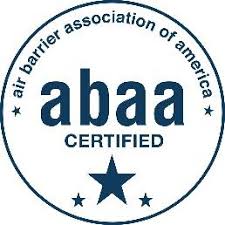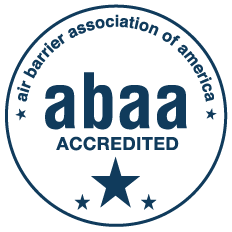Who is ABAA and What it Means to You!

The ABAA is the Air Barrier Association of America; it was incorporated in March 2001 by then and current Executive Director, Mr. Laverne Dalgleish. In the last 14 years it has become international in its membership. The ABAA consists of a wide variety and cross section of industry members including air barrier applicators, general contractors and construction managers, air barrier material manufacturers, design professionals, testing and inspection agencies, consultants and testing laboratories. Its’ mission is to develop a professional air barrier specialty trade and industry dedicated to the installation of effective air barrier systems in buildings.
What is an air barrier?
Air barriers control the unintended movement of air into and out of a building enclosure. Air barrier systems are comprised of a number of materials which are assembled together to provide a complete barrier to air leakage through the building enclosure. The building enclosure includes all six sides of the building and may include separations within a building. This system essentially “wraps” the building shell and ensures that it protects the building from the effects of air leakage. Air leakage can have detrimental effects on how a building functions and reduces the life span of a building.
What are the benefits?
A properly functioning air barrier system provides a barrier against both the air leakage and the diffusion of air caused by wind, stack and mechanical equipment pressures.
For the occupants to be comfortable, air is conditioned in buildings. In summer or in cooling climates, the air is normally cooled and dehumidified to a lower temperature and humidity than the exterior environment. In winter or heating climates, air is normally heated and humidified to a higher temperature and humidity than the exterior. When this conditioned air leaks out of a building and unconditioned air leaks into a building, additional energy is used to then condition this air. Air leakage can result in an increased use in energy costs of up to 30-40% in heating climates and 10-15% in cooling costs according to the National Institute of Standards and Technology (NIST). Buildings which have a properly installed air barrier system can operate properly with a smaller HVAC system as the mechanical engineer does not have to compensate for a leaky building. In some cases, the reduction in mechanical equipment size and cost can offset the cost of the air barrier system.
Air barrier systems also provide a barrier to pollutants entering either the building or the building enclosure. Water vapor, suspended particulates, dust, insects, smells, etc., are all pollutants that are to be kept out of either the building in general or the building enclosure. Water vapor that leaks into the building enclose (from the inside in heating climates and from the outside in cooling climates) can condensate and form liquid water – a key ingredient to corrosion and the potential development of mold.
ABAA Certification  Certification is one of the keystones of the ABAA. Materials and contractors are trained, rigorously tested and continually educated on air barrier technology. Is certification of products and contractors important? Yep it sure is! Ms. Kimberly Kayler, CPSM, Board of Directors of ACI recently wrote in the Construction Specifier Magazine, June 2015, “Certification in the construction industry provides good ROI and market differentiation, as well as improves safety and quality by establishing best practices. The benefits include increased safety, less material waste, and early identification of design and construction challenges, as well as creating a pool of extremely qualified and trained individuals well-suited for your project.”
Certification is one of the keystones of the ABAA. Materials and contractors are trained, rigorously tested and continually educated on air barrier technology. Is certification of products and contractors important? Yep it sure is! Ms. Kimberly Kayler, CPSM, Board of Directors of ACI recently wrote in the Construction Specifier Magazine, June 2015, “Certification in the construction industry provides good ROI and market differentiation, as well as improves safety and quality by establishing best practices. The benefits include increased safety, less material waste, and early identification of design and construction challenges, as well as creating a pool of extremely qualified and trained individuals well-suited for your project.”
Manufacturer Evaluated Assemblies that are listed on the ABAA web site (airbarrier.org) have undergone rigorous third party testing evaluation, not only for their air barrier properties, but for their entire performance in an assembly in tests such as crack bridging ability, fastener sealability, adhesion to substrates and several other architectural/engineering properties that are necessary for good performance on the wall. The listing on the ABAA web site is constantly updated and if a manufacturer isn’t listed then they either haven’t submitted their tested materials or they are engaging in what I euphemistically call “information enhancement”. Any air barrier materials that are ABAA evaluated should arrive at your job site prominently bearing the ABAA label.
 An ABAA Accredited Contractor is undoubtedly one of the more experienced and robustly trained and educated contractors on your building. To become an ABAA Accredited Contractor a company must provide proof of financial viability and employ at least one ABAA Level 3 Certified Installer and sign an Accredited Contractor Licensing Agreement. The firm that is issuing this newsletter, Chamberlin, has several Certified Installer personnel on staff. The constant training and continuous education of these personnel requires contractors to lay out several tens of thousands of dollars a year.
An ABAA Accredited Contractor is undoubtedly one of the more experienced and robustly trained and educated contractors on your building. To become an ABAA Accredited Contractor a company must provide proof of financial viability and employ at least one ABAA Level 3 Certified Installer and sign an Accredited Contractor Licensing Agreement. The firm that is issuing this newsletter, Chamberlin, has several Certified Installer personnel on staff. The constant training and continuous education of these personnel requires contractors to lay out several tens of thousands of dollars a year.
ABAA Quality Assurance Program (QAP)
The QAP encompasses a variety of initiatives that include prequalification requirements of contractors and installers, training and education, a method for installers to self-test their work, a paper trail of the entire installation process, an independent auditor to confirm compliance with the QAP program and ABAA specifications, and a process to deal with the loss of license by an individual participating in the program. This program has been developed for all parties involved including architects, engineers, building owners, contractors and material manufacturers.
The Auditors are all from an independent third party agency and have no affiliation with the general contractor, the ABAA accredited installer or the manufacturer. Their reports are reviewed by the Technical Staff at ABAA and corrective action, if required, is implemented. All reports are filed with the ABAA Accredited Contractor, the general contractor, the architect, the building owner and the materials manufacturer. Nothing is hidden, and complete transparency is the standard of care.
So, how does this all work to benefit all involved?
Consider this scenario: As the owner of my own firm I decide to build my brand new Global Intergalactic Headquarters office. I hire an architectural firm, Real Good Architects LLP, who are known for their energy efficient building design. They prepare documents and specifications that reflect their specialty and they use ABAA Guidelines for the basis of design. The project goes out for bid and the low general contractor, Super Good Building Contractors LLC is the apparent low bidder but they are over budget. I hit the roof at being over projections so I begin to discuss the value engineering opportunities with my construction team and we land on the air barrier section. Yes, this is the section and specification that pays for itself via an up to 40% reduction, according to NIST/DOE, in energy costs over the life of the building. It also keeps buildings dry by blocking both rain and water vapor from entering the building and has been tested to be able to bridge cracks and seal around the brick tie fasteners.
We look at the three low bidders:
- Ed’s Airline, Flight Insurance, Storm Door and Awning Firm has heard about this new air barrier stuff and wanted to get in to it so they bid the job. BID: $95,000
- Lower Bid Air Barrier Company has done two Air Barrier jobs this year. They are pretty sure that they followed ABAA Guidelines, but couldn’t swear to it. None of their personnel are a Certified Level 3 installer and if I really want that QAP thingy they will have to add more money. BID: $99,999.99 plus that QAP thing, if you really want it and we could qualify to get it.
- Waterproofing Professionals, Inc. has been an ABAA Accredited Contractor for years spending tens of thousands of dollars on ABAA Certification and training, their bid includes experienced, trained ABAA Certified personnel, continuing education, hundreds of jobs in place and the cost of the QAP Program. BID: $105,000
So what are the building owner, architect and general contractor to do? The building is slightly over budget, decision time is closing in. As the owner, I make the executive decision. I throw out the left-hand polished 400 year-old Venetian pink marble that lined the outside of the two story elevator shafts and had the general contractor hire The Waterproofing Professionals, Inc. Long-term value and building performance decisions are easy to make once you know the facts. Learn more at airbarrier.org.

Roy Schauffele, FCSI, CCPR, FABAA, LEED Green Associate, ABAA Certified Air Barrier Specialist is an internationally published author and speaker in the fields of energy conservation and sustainable building envelopes including insulation, air barrier technology, roofing & waterproofing, vegetative & cool roofing, all with an eye towards improving building science, performance and quality of life. He is the acknowledged inventor of “The Perfect Wall” which is now the nationwide building code standard for wall construction. He is President and Founder of Division 7 Solutions, Inc., now entering its 32nd year of continuous operations. He was the first Technical Director of SPRI (Single Ply Roofing Institute) and a Construction Specifications Institute (CSI) Board Director. He has been an elected City Councilperson, a Texas Senate and Gubernatorial appointed official in the State of Texas and currently serves by mayoral and city council appointment on the City of San Antonio, Small Business Advocacy Committee. He currently serves as a Past Board Chairman of the ABAA (Air Barrier Association of America), after three terms as Chairman and the first Regional ABAA Advocate. He is a Technical Advisor to Build San Antonio Green (BSAG), an award winner in 2012 for his Technical Contributions to BSAG and was named the (2016) Individual Green Practitioner by the City of San Antonio for Sustainable Education and Outreach. Globally, he is the only person to be a Fellow of both CSI and ABAA, and at this time he is the only Certified Air Barrier Specialist. He continues to be a requested national speaker on air barriers, roofing, insulation, energy conservation design and sustainability. Roy can be reached at 210-859-3749 or roys@division7.com.
Subscribe Today!
Stay-in-the-know and subscribe to our blog today!